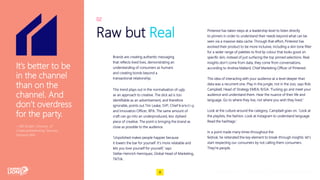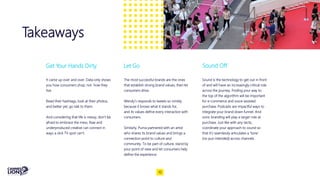Consumer experience
- 2. Introduction Overview of Insights Takeaways Trends Human, actually. • Co-Creation and Fluidity • Raw and Real • Sound is the New Screen • Get Your Hands Dirty • Let Go • Sound Off 2
- 3. Introduction The biggest ideas about consumer experience at the 2019 International Festival of Creativity centred on tapping into shared humanity. Again and again, the point was made that we respect our audience much more by gathering insights about their lived lives, rather than defining them by data. In doing so, brands are reaching out to consumers to collaborate with them on building the brand, and creating new ways to communicate beyond screens. Consumer Experience FIFA's campaign merged video gaming with IRL. 3
- 4. Human, actually. Capitalize on low hanging fruit to identify a ballpark Consumer experience is putting the consumer at the centre of everything. It’s personalisation. It’s a seamless, omni-channel ecosystem. The buzzwords abound. But the reality is, in an increasingly fluid and connected marketing landscape, the stakes are high to develop a world-class CX. According to Forbes, 80 percent of companies feel they provide ‘super experiences,’ yet only 8 percent of consumers agree. So regardless of how often we all talk about CX at meetings and conferences, actually delivering on it is relatively rare, and provides a huge opportunity to differentiate. 4
- 5. Human, actually. Capitalize on low hanging fruit to identify a ballpark ‘Most of the consumer’s day is not spent consuming, it’s spent living.’ —Andrea Mallard, Chief Marketing Officer, Pinterest 5 This year at Cannes, the discussion of CX included artificial intelligence, the Internet of Things, mixed reality, voice and even sound. But at a high level, the conversation has shifted toward a more fundamental point of view. You need channels connected across touchpoints but the point of that is to power an experience that connects at a human level. ‘More data will not save us,’ is the word from Martin Weigel, Head of Planning at Wieden+Kennedy. CX success stories included using gaming, social or voice technology to allow consumers to actively participate in the experience—and help shape the brand. Case in point: Hey Google, Ask Nike, an award- winning collaboration that allowed consumers to shop the NBA game for shoes worn by the players via voice, and engage more deeply in the game and with the players they love. The theme of recognising shared humanity also played out in design principles, with a movement toward even more raw and less stylised creative. According to Tim Leake of RPA, ‘Really good is good, really bad is good…it’s the stuff in-between that’s inefficient.’ Making deep connections at a human level means leveraging the most intuitive form of communication, natural language. According to 360i, voice assistants can be valuable beyond e-commerce, as brands are finding ways to create moments of humanity to actually assist when hands are not available. For example, National Geographic and 360i paired up to create Bravo Tango Brain Training, a way for veterans with PTSD to connect to a voice assistant in moments of need, to get feedback to help them re-centre, or to connect them to people who will help. And brands using sound in innovative ways brought home big prizes. Wavio and Area 23 won the Grand Prix for Innovation with ‘See Sound,’ a mobile app that analyses sound data via AI to alert hearing-impaired users of abnormal sounds in their house with a text to their smartphones. The brand and agency worked in collaboration with Google to assess sounds like fire alarms, babies crying and dogs barking, via over 2 million videos with discrete sound clips. While the technology is complex, the experience is incredibly simple, marrying data, tech, and design into a seamless and intuitive CX.
- 6. Theme: Consumer Experience 02 0301 Successful brands like Nike, FIFA, Puma, and Wendy’s are creating frameworks in which consumers are co-creators of the experience. Trends Co-creation and Fluidity Tapping into shared humanity means creating a point of view that includes the messiness of lived lives. This requires doing the work to dive deeper than data, ensuring your brand is responding to real pain points. Raw but Real Whether it’s voice assistants, podcasts, or branded tones, sound is the next frontier in consumer experience. Sound is the New Screen Less stylized creative brings impact, according to Tim Leake, RPA 6
- 7. 01 Co-creation and Fluidity We set up the rules but people create the brand in an open source way. —Adam Petrick, Global Director, Brand Marketing, PumaSuccessful brands are creating experiences that include consumers in brand building across a multitude of channels in joyful and authentic ways. With FIFA, that means acknowledging that not only does the real football game influence the video game, but the video game—and the way players engage with it— influences the real game. Using that insight, adam&eveDDB worked with Ronaldo to develop a new move (IRL), the El Tornado. Then they hid it in the game, creating a massive search for the controller combo that unlocked the move, resulting in 46 million shared GIFs and deeply engaged FIFA fans. Puma’s strategy has been to create partnerships that drive connections to consumers, including with recording artist Big Sean, who self-identifies with Detroit style and culture, and influences the brand with his strong design point of view. Grand Prix winner Carling rolled out its campaign built from their consumer base, with digital-only fashion sold for people who want to be seen on Instagram in amazing outfits, but don’t want the carbon footprint of disposable clothes. Consumers shared their outfits on social, and the limited collection sold out within a week. Finally, whether it’s sparking nugget kid fandom or launching original hip-hop tracks in response to a tweet war, the Wendy’s team at VMLY&R brings the sassiness of Wendy’s voice to life with real consumers. And the strategy works for gaming too. The Wendy’s team dropped into the Burger vs. Pizza war in Fortnite, destroying their singular nemesis: the freezers. Adam Petrick and Big Sean discuss co-creation of the Puma brand. 7
- 8. Raw but Real Brands are creating authentic messaging that reflects lived lives, demonstrating an understanding of consumers as humans and creating bonds beyond a transactional relationship. This trend plays out in the normalisation of ugly as an approach to creative. The slick ad is too identifiable as an advertisement, and therefore ignorable, points out Tim Leake, SVP, Chief Marketing and Innovation Officer, RPA. The same amount of craft can go into an underproduced, less stylised piece of creative. The point is bringing the brand as close as possible to the audience. ‘Unpolished makes people happier because it lowers the bar for yourself. It's more relatable and lets you love yourself for yourself,’ says Stefan Heinrich Henriquez, Global Head of Marketing, TikTok. Lorem ipsum dolor 02 Pinterest has taken steps at a leadership level to listen directly to pinners in order to understand their needs beyond what can be seen via a massive data cache. Through that effort, Pinterest has evolved their product to be more inclusive, including a skin tone filter for a wider range of palettes to find lip colour that looks good on specific skin, instead of just surfacing the top pinned selections. Real insights don’t come from data, they come from conversations, according to Andrea Mallard, Chief Marketing Officer of Pinterest. This idea of interacting with your audience at a level deeper than data was a recurrent one. Play in the jungle, not in the zoo, says Rob Campbell, Head of Strategy EMEA, R/GA. ‘Fucking go and meet your audience and understand them. Hear the nuance of their life and language. Go to where they live, not where you wish they lived.’ Look at the culture around the category, Campbell goes on. ‘Look at the playlists, the fashion. Look at Instagram to understand language. Read the hashtags.’ In a point made many times throughout the festival, he reiterated the key element to break-through insights: let’s start respecting our consumers by not calling them consumers. They’re people. It’s better to be in the channel than on the channel. And don’t overdress for the party. —Bill Roden, Director of Creative/Marketing Services, General Mills 8
- 9. Sound is the New Screen 03 We’re very good at doing marketing on screens. We’re not as good at audio only. —Bessie Lee, Founder and CEO, Withinlink From voice assistants to podcasts to branded tones, sound is the new frontier for marketers. With 66 million voice assistants in the U.S., up 40 percent since 2018 and growing, voice is the channel to get out in front of. And a rising challenge for marketers is creating a strategy to deliver messaging without a screen. Consumers are using voice assistants in private spaces, says Bessie Lee, Founder and CEO of Withinlink. The kitchen, the microwave, the refrigerator, the car. They will expect personalised messages back, not generalised, or worse, advertising. And the messaging is limited: Ask, ‘What’s the best lipstick?’ and assistants will recommend one brand. So how can you make sure you are the brand? Winning the top of the algorithm will be key to e-commerce strategies in the near term. Notably, while most coders are male, most consumers ordering via voice are female. 'Hire more female coders,' suggests Bessie, to help tap into real use cases. Human voice as a long-form creative medium is on the rise as podcasts are becoming key to integration strategies for brands. Podcasting creates loyalty and trust, and establishes an extended period of attention with consumers. ‘People will listen to 40 minutes of content on average; that’s a long time for a brand to engage with an audience,’ says Zuleika Burnett, Executive Director, Creative and Innovation, Havas Life Medicom. Critical to a podcast is tone. You can’t fake it. Sincerity and authenticity are what consumers are looking for to bring hope, information, and community. Categories that are effective? Specialised knowledge and real stories. Finally, brands are beginning to explore not just human voice but sound itself. Visa created a sound at point of purchase that reflects the trust and security of the brand, and drives confidence in the merchant. In doing so, they began with over 200 sounds, narrowed it to 20, then focus tested, asking respondents how the sounds made them feel, even paying attention to physical reactions of the respondents. ‘As a global brand, you need to be mindful. What’s energetic for me isn’t for others,’ says Lynne Biggar, Chief Marketing and Communications Officer at Visa. 9
- 10. Takeaways Get Your Hands Dirty It came up over and over. Data only shows you how consumers shop, not how they live. Read their hashtags, look at their photos, and better yet, go talk to them. And considering that life is messy, don’t be afraid to embrace the mess. Raw and underproduced creative can connect in ways a slick TV spot can’t. The most successful brands are the ones that establish strong brand values, then let consumers drive. Wendy’s responds to tweets so nimbly because it knows what it stands for, and its values define every interaction with consumers. Similarly, Puma partnered with an artist who shares its brand values and brings a connection point to culture and community. To be part of culture, stand by your point of view and let consumers help define the experience. Let Go Sound is the technology to get out in front of and will have an increasingly critical role across the journey. Finding your way to the top of the algorithm will be important for e-commerce and voice-assisted purchase. Podcasts are impactful ways to integrate your brand down funnel. And sonic branding will play a larger role at purchase. Just like with any tactic, coordinate your approach to sound so that it’s seamlessly articulates a 'tone' (no pun intended) across channels. Sound Off 10









